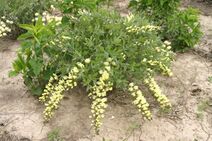Baptisia bracteata
| Baptisia bracteata | |
 | |
| Light: | |
| Moisture: | |
| Hardiness: | 5 |
| Soil pH: | 5.6-7.3 |
| Height: | 2' |
| Width: | 2' |
| Blooms: | Late Spring-Early Summer |
| Native to: | |
| Nitrogen Fixer Nectary | |
| Medicinal Rating: | |
| Tea: | Yes |
Baptisia bracteata (common names: plains wild indigo and cream wild indigo)
Once plentiful on parries prior to human colonization, this long-lived perennial is now registered as a special concern due to large-scaled conversions of parries and savannas to row-crop agriculture and livestock grazing. This skipper and sulfur butterfly host plant persists in isolated pockets along roadside ditches and medians but is being threatened by changing road-side maintenance policy’s increased mowing and herbicide use. Seeing this plant, with its dense cascading raceme of creamy yellow pea-shaped blossoms, in nature is now truly special as you are on one of the few remnants of prairie or a well-planed prairie recreation. The unique horizontal flower spikes often touch the ground from the weight of the blossoms and its dense crown of blue-green foliage resembles a bubbling fountain with cascading plumes. Creamy flowers turn charcoal black as seed pods in develop in late summer. The seed pods are prolific producers of easy-to-grow seeds to share. The deep taproot permits this nitrogen-fixing flower to withstand dry conditions and heat.
Propagation: Seed - best sown as soon as it is ripe in a cold frame[1]. Stored seed should be pre-soaked for 24 hours in warm water and then sown in a cold frame in late winter or early spring. Prick out the seedlings into individual pots as soon as they are large enough to handle and plant them out into their permanent positions in the summer or following spring.
Division in spring[2]. Larger divisions can be planted straight into their permanent positions whilst smaller clumps are best potted up and kept in a cold frame until they are growing away well.
Cultivation: Prefers a deep, well-drained neutral to slightly acid soil in full sun[2][1]. Grows freely in a loamy soil[3]. Succeeds in a hot dry position. Succeeds in a rich moist soil in sun or light shade[4].
Hardy to about -20°c[4].
Plants have a very deep root system and dislike root disturbance, they should be left alone once they are established[2][5].
This species has a symbiotic relationship with certain soil bacteria, these bacteria form nodules on the roots and fix atmospheric nitrogen. Some of this nitrogen is utilized by the growing plant but some can also be used by other plants growing nearby[1].
Range: Eastern N. America - Arkansas, Texas and Nebraska to Minnesota.
Habitat: Dry soils[6] on prairies[7]. Sandy open woods, prairies, pastures and roadsides in Texas[8].
Medicinal: An ointment made from the ground seeds is applied to the stomach in the treatment of colic[6].
A tea made from the roots is used in the treatment of typhoid and scarlet fever[6].
The leaves are astringent and are applied externally to wounds etc[6].
Recent research suggests that the plant can stimulate the immune system[6].
Soil: Can grow in light and medium soils.
Drainage: Prefers well drained soil.
Seed Ripens: Late Summer-Early Fall
Flower Type: Hermaphrodite
Known Hazards: The plant is potentially toxic[6].
Also Known As: B. leucophaea. Nutt. B. villosa. Auct.
Links
References
- ↑ 1.0 1.1 1.2 Huxley, Anthony. The New Royal Horticultural Society Dictionary of Gardening. MacMillan Press, 1992.
- ↑ 2.0 2.1 2.2 Brickell, Christopher. The RHS Gardener's Encyclopedia of Plants and Flowers. Dorling Kindersley Publishers, 1990.
- ↑ Chittendon, Fred. RHS Dictionary of Plants. Oxford University Press, 1951.
- ↑ 4.0 4.1 Phillips, Roger and Martyn Rix. Perennials - The Definitve Reference. Pan Books, 1991.
- ↑ Thomas, Graham. Perennial Garden Plants. J. M. Dent & Sons, 1990.
- ↑ 6.0 6.1 6.2 6.3 6.4 6.5 Foster, Steven and Billy Tatum. Medicinal Plants of Eastern and Central North America. Houghton Mifflin, 1990.
- ↑ Britton, Nathaniel and Addison Brown. An Illustrated Flora of the Northern United States and Canada. Dover Publications, 1970.
- ↑ Diggs, George and Barney Lipscomb. Illustrated Flora of North Central Texas. Botanical Research Institute, 1999.